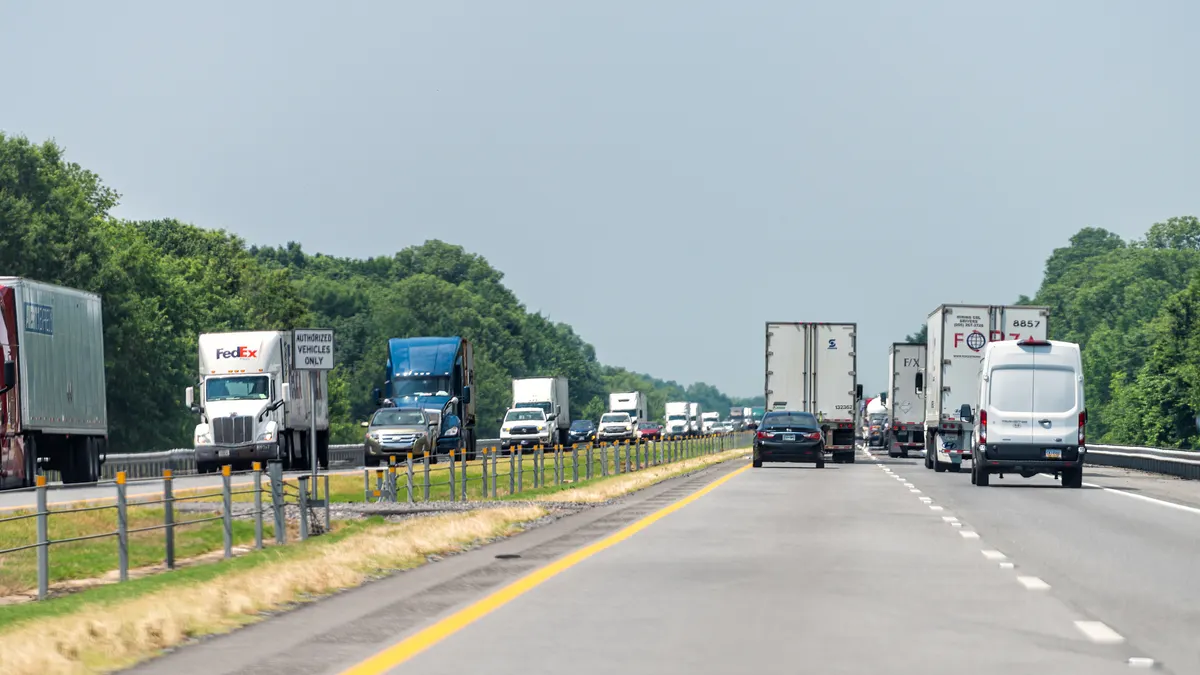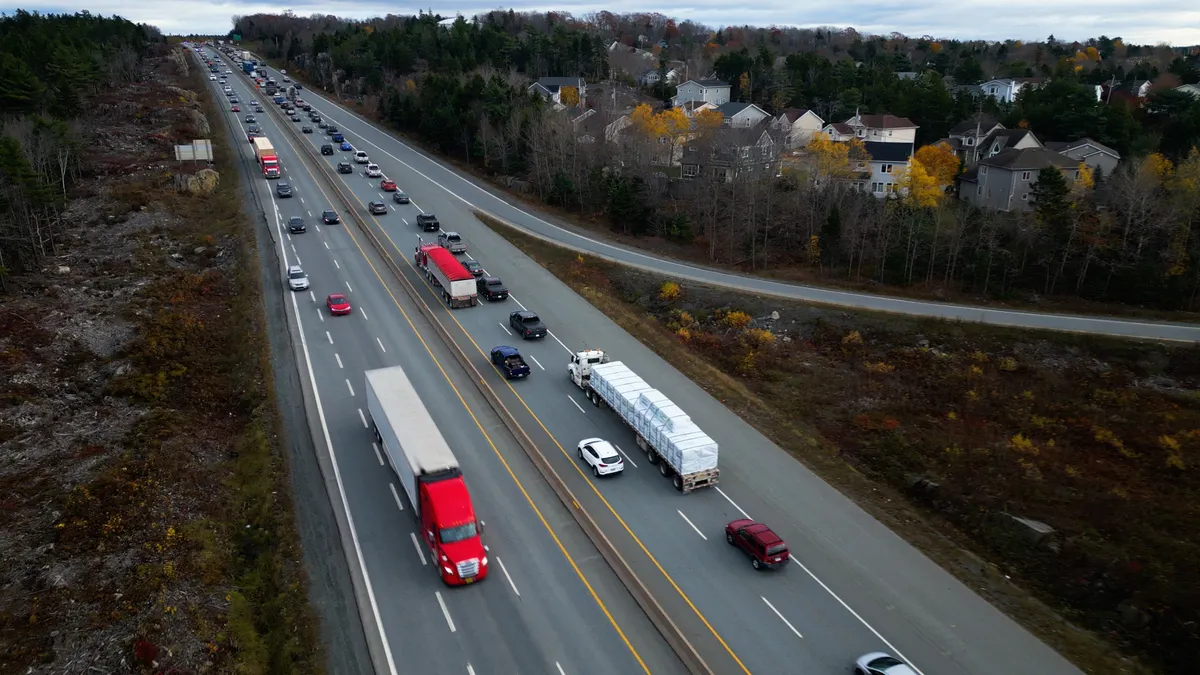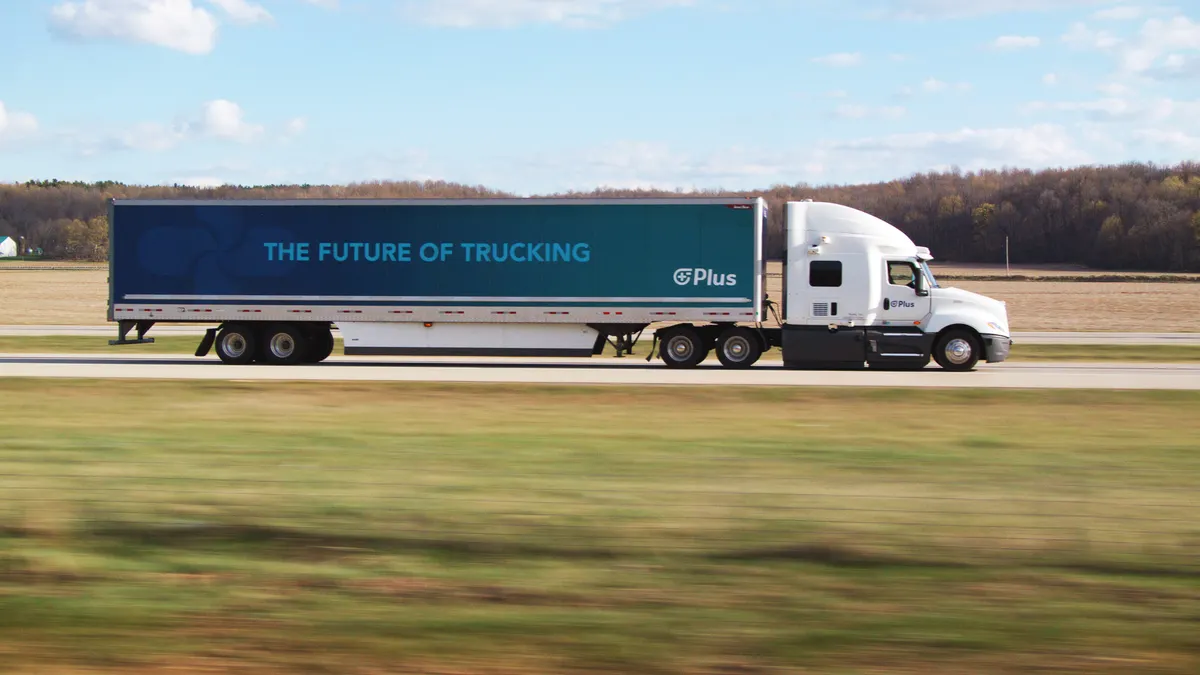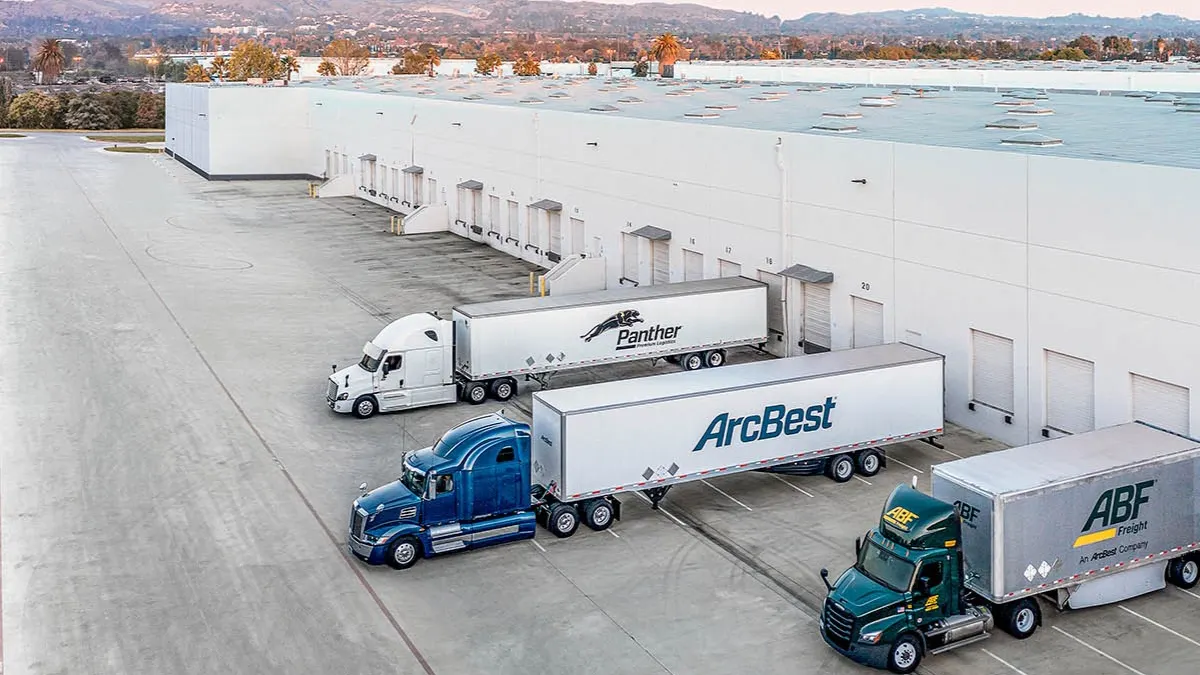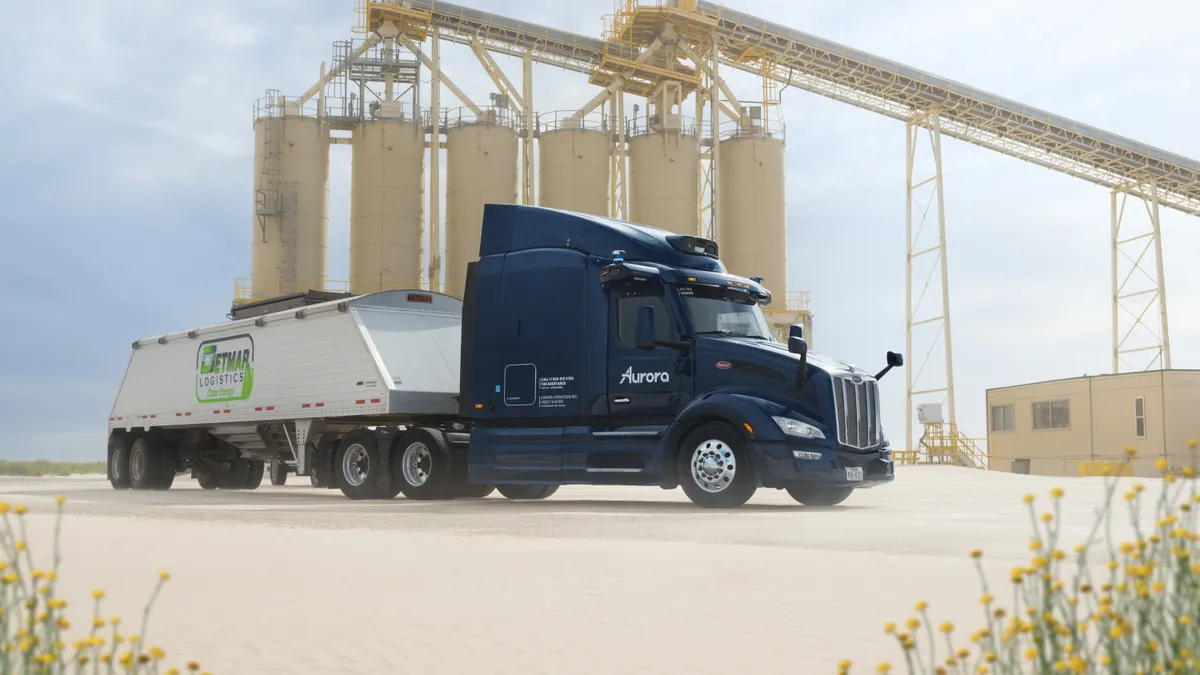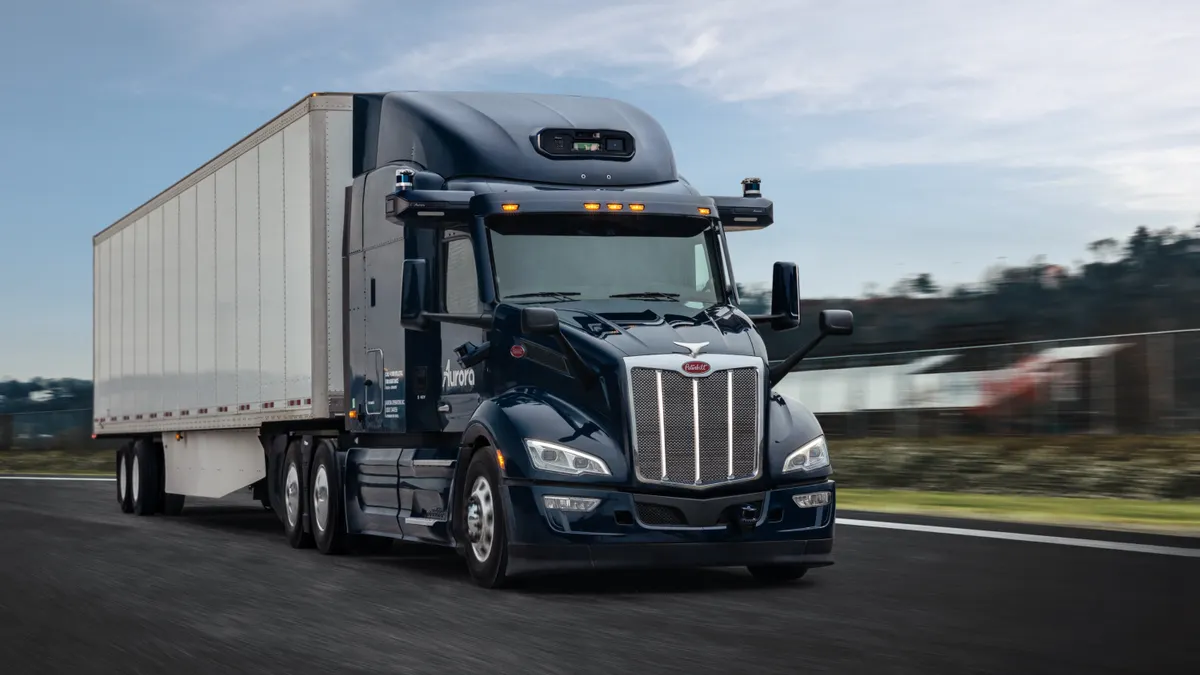This is an opinion piece by Paul Stith, director of global transportation initiatives for Black & Veatch. Views do not necessarily reflect those of Transport Dive.
Long-haul truckers reliant on fossil fuels may find themselves at a transformational crossroads, whether they’re shipping cars or cabbages. Technology and its promise of a cleaner, greener way of moving freight is changing the trucking industry — and fleets should be preparing now.
The coronavirus is contributing to the momentum behind the adoption of green technology. It has exposed weaknesses in supply chains, and the economic fallout makes the need for commitment to greater resiliency through electrified or hydrogen-powered fleets more glaring.
Regulation is also driving the development of semi rigs propelled by electric motors, or the increasingly embraced prospect of hydrogen-powered fuel cells. California and a handful of other states have imposed or are consideringmandates that trucking fleets wean themselves from diesel fuel to decarbonize their footprints. Public clamoring for cleaner air is amplifying that push.
Such rigs still are in development, not yet ready for prime time. The tools needed to meet zero-emissions goals often take years to go from concept to actual deployment. But they’re coming soon, and fleets must start taking action.
The dilemma of switching gears
Despite increasing calls for enterprises to adopt trucks that cut greenhouse gas emissions, those pressed to do so must thoughtfully weigh whether the sizable investment makes financial sense or inflicts the least financial pains.
Will there be a clear financial benefit? If greener shipping is the path, should operators go with a pilot push to simply test the waters? Or should they take the plunge, committing with the upfront investment to make the transition at once? Is there enough of a supply of green vehicles to meet the demand at a reasonable price?
The tools needed to meet zero-emissions goals often take years to go from concept to actual deployment. But they’re coming soon, and fleets must start taking action.

With such soul-searching comes an inescapable truth: Companies willing to kick the tires and go electric, with fleets big or small, must take serious steps now, appreciative that the bigger the inventory of vehicles to be replaced, the more pressing the need to finally start sorting it all out.
But fleet operators’ appetite to commit to electrified or hydrogen-fueled trucks appears murky. Diesel fuel remains the standard for semi-tractors, and enterprises with fleets still question the range and sticker price of zero-emissions trucks. Electric trucks are clearly more expensive than their diesel-powered counterparts, though those costs may diminish when electric vehicles reach scale.
Production is well on its way
OEMs are looking to scale production soon.
Nikola Motor, for example, told Transport Dive in March that it has 14,000 trucks on pre-order, with the first delivery of battery-electric trucks to European fleets expected next year. Trevor Milton, Nikola founder and former executive chairman, insisted on his LinkedIn page that the company’s trucks boasting a range of 300 miles on battery power and 500 miles on fuel cells with an 80,000-pound load isn’t "all talk."
Roger Nielsen, chief executive at Daimler Trucks North America, touted to hundreds of attendees at the ACT Expo in California last year that "the road to emissions-free transportation is going to be driven with battery-electric vehicles," also declaring he believes "the future is electric."
Fleet operators need to be convinced that the green technologies being deployed by makers of heavy-duty Class 7 or Class 8 tractors can reliably handle the segment’s grueling environmental and hauling demands.

But amid such soaring optimism, significant potential barriers to broader adoption loom. Fleet operators need to be convinced that the green technologies developed for Class 7 or Class 8 tractors can reliably handle the segment’s grueling environmental and hauling demands.
With diesel fuel still relatively cheap, will companies make the shift to electric or hydrogen sources that are more expensive?
Whatever the case, one thing is clear: There’s no time to be idling about considering the change, even if many of the prototype trucks are still in the test stages.
Collaborating on infrastructure
Along with the investment in tractors, there's also the daunting upfront investment in replenishing the sources that power them — and the complexities of that technology.
Will the local utility step up with the power commitment and infrastructure to meet the charging demands, eliminating an enormous hindrance to moving the commercial electric vehicle market from niche to mainstream? Doing so would widen usage beyond what now is merely short hauls from around shipping ports and coastal urban transportation corridors.
And there's the persisting chicken-and-the-egg scenario: Fleet operators don’t want to buy a zero-emissions truck, unless they have in place the means to charge them. But to build out the charging requires a decision about what kind of vehicle is best. Will a new electric substation be needed, taking a couple of years to build?
While the challenges of transitioning to greener, cleaner trucking can be offset by broader opportunity. Taking the investment plunge can be a deep, analytical exercise, given the cost of the vehicles and the infrastructure needed to power them.
Going the extra mile to accelerate the adoption of EVs assuredly will require the industry’s collaboration with utilities to build out the needed charging infrastructure.
The power of hydrogen
While battery technology has gotten more attention and traction, hydrogen is enjoying wider mindshare as a sustainable option through electrolyzer technology that produces the gas from water, as well as other sustainable sources like biomass and waste-recovery technologies.
Drivers using a hydrogen system — fuel cell stacks and tanks — can fuel their vehicles nearly as quickly as they can at a diesel pump and in less time than it takes to recharge batteries, though that technology is improving. Hydrogen-powered systems also are lighter than battery-electric ones, meaning more space for cargo and, by extension, greater profits.
But aside from the lack of availability of hydrogen-fuel-cell trucks, another glaring obstacle remains: Trucking companies that go that route will need places to fuel, and for now those stations don’t exist.
But Nikola is working with Oslo-based partner Nel Hydrogen to have hydrogen fuel cell Class 8 in production in the United States by 2023 and the necessary fueling stations in targeted sites. Nikola previously announced plans to have more than 700 hydrogen stations across the United States and Canada by 2028. Other truck makers — Hyundai, Daimler AG and Volvo, to name a few — are engaged in developmental efforts.
Many motor carriers, for now, are on the sidelines, waiting to see hydrogen infrastructure crop up at any kind of scale before breaking away from diesel. But given pressures from politicians and America’s populace for motor carriers to go modern, migrating to zero-emission trucks remains a golden opportunity and requires collaboration from multiple parties — end users, businesses, infrastructure providers and policymakers — for the industry to get in gear.
Concerns and upsides
Commercial fleets are becoming increasingly open to using zero-emissions trucks, as new models go into production and upfront purchase prices come down. In fact, product availability is improving rapidly.
In the heavy-duty North American market alone, as GreenBiz reported in June, 19 zero-emission truck models (either battery electric or hydrogen fuel cell) from 14 manufacturers are expected to be in production within the next three years. This represents an impressive 280% increase in the five Class 8 models commercially available today.
Funding incentives — such as loans, rebates, tax credits and grants — are increasingly available for vehicles and required infrastructure in certain regions. Going greener enables operators to trumpet their roles in helping clear the air of greenhouse gas emissions, lessening their carbon footprint.
But will onboard batteries and fuel cells displace too much of the valuable space for the actual freight, cutting into margins and efficiency? At least for now, batteries are big and heavy, outweighing diesel engines. Concerns about the range of the trucks are real, stoking questions about the practicality of batteries for long hauls, even though that technology is evolving and improving.
There are tangible upsides to making the change, though: Electric trucks require less maintenance, fuel costs are more predictable and less volatile, worker productivity flourishes and, of course, pollution diminishes. That makes a powerful strategic case for long-term sustainability for fleet operators looking beyond simply the next operational quarter but years down the road.
To submit an opinion piece for publication on the Transport Dive website, please visit https://www.transportdive.com/opinion/submit-opinion/ and view our guidelines and submission form.


